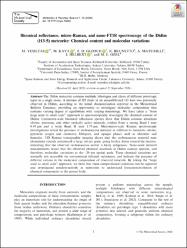Biconical reflectance, micro-Raman, and nano-FTIR spectroscopy of the Didim (H3-5) meteorite: Chemical content and molecular variations
Abstract
The Didim meteorite contains multiple lithologies and clasts of different petrologic types in a single stone. A mixture of H5 clasts in an unequilibrated H3 host was previously observed in Didim, according to the initial characterization reported in the Meteoritical Bulletin Database, providing an opportunity to investigate molecular composition that contains varying degree of equilibrium with varying mineralogy. We have taken a from large scale to small scale approach to spectroscopically investigate the chemical content of Didim. Centimeter-scale biconical reflectance spectra show that Didim contains abundant olivine, pyroxene, and other optically active minerals, evident from a strong Band I near 0.93 mu m and a weak Band II near 1.75 mu m. Micrometer-scale Raman spectroscopic investigations reveal the presence of carbonaceous material in addition to forsteritic olivine, pyroxene (augite and enstatite), feldspars, and opaque phases such as chromite and hematite. 3-D Raman tomographic imaging shows that the carbonaceous material near chondrules extends underneath a large olivine grain, going further down toward the interior, indicating that the observed carbonaceous matter is likely indigenous. Nano-scale infrared measurements reveal that the observed chemical materials in Didim contain spectral, and therefore, molecular, variations at the similar to 20 nm spatial scale. These chemical variations are normally not accessible via conventional infrared techniques, and indicate the presence of different cations in the molecular composition of observed minerals. By taking the large scale to small scale approach, we show that these compositional variations can be captured and investigated nondestructively in meteorites to understand formation/evolution of chemical components in the parent body.



















